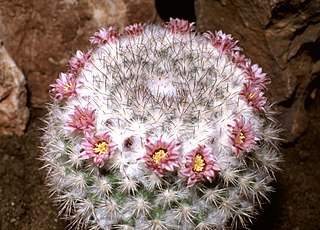
Mammillaria is one of the largest genera in the cactus family (Cactaceae), with currently 200 known species and varieties recognized. Most of the mammillaria are native to Mexico, but some come from the southwest United States, the Caribbean, Colombia, Venezuela, Guatemala and Honduras. The common name "pincushion cactus" refers to this and the closely related genus Escobaria.

Cochemiea is a genus of cactus. It has previously been synonymized with Mammillaria, but molecular phylogenetic studies have shown that when broadly circumscribed, Mammillaria is not monophyletic, and Cochemiea has been accepted as a separate genus.

Mammillaria dioica, also called the strawberry cactus, California fishhook cactus, strawberry pincushion or fishhook cactus, is a cactus species of the genus Mammillaria. Its common name in Spanish is biznaga llavina.
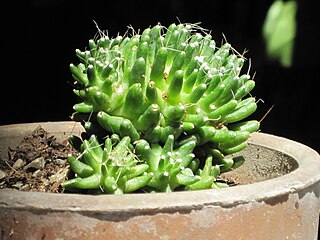
Mammillaria painteri is a species of plant in the family Cactaceae. It is endemic to Mexico. It is usually found near, but not limited to, San Juan del Rio, Guanajuato. It is commonly referred to as the biznaguita in Spanish. It is also known by many to be synonymous with Mammillaria crinita subspecies crinita. It was evaluated and added to the IUCN Redlist in 2002 as data deficient. The causes of this species' endangerment or threats to its well-being are not clear.

Mammillaria rhodantha, the rainbow pincushion, is a plant in the cactus family (Cactaceae) and is one of 171 species in the genus Mammillaria which are characterized by having nipple-shaped tubercles or prominences on their surface.

Mammillaria spinosissima, also known as the spiny pincushion cactus, is a species of flowering plant in the cactus family Cactaceae, endemic to the central Mexican states of Guerrero and Morelos, where they grow at elevations of approximately 1,600 to 1,900 metres. The species was described in 1838 by James Forbes, gardener of the Duke of Bedford. Botanist David Hunt collected a specimen in 1971, when he located one near Sierra de Tepoztlan, Mexico.

Mammillaria marksiana is a cactus in the genus Mammillaria of the family Cactaceae.

Mammillaria grusonii is a cactus in the genus Mammillaria of the family Cactaceae. The epithet grusonii honors the inventor, scientist, industrialist and cacti collector Hermann Gruson of Magdeburg.
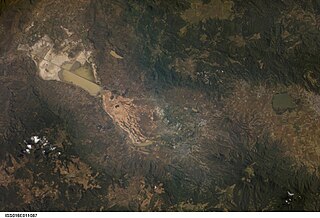
Laguna de Sayula is a lake located in the southern area of Jalisco, about 60 km from Guadalajara. It is located in the municipalities of Sayula, Zacoalco de Torres, Amacueca, Teocuitatlán de Corona, Atoyac and Techaluta de Montenegro.

Mammillaria carmenae, the Isla Carmen pincushion cactus, is a species of flowering plant in the family Cactaceae.

Mammillaria standleyi is a species of the family Cactaceae native to the Sierra Madre Occidental of Sinaloa, Chihuahua and Sonora. It has red-purple flowers surrounded by cottony pubescence. Fruits are red and edible, tasting like apples, although too small to be of much food value to humans.

Mammillaria lasiacantha is a species of cactus in the subfamily Cactoideae, with the common names lacespine nipple cactus, small pincushion cactus, and biznaga de espinas pubescentes (Spanish).
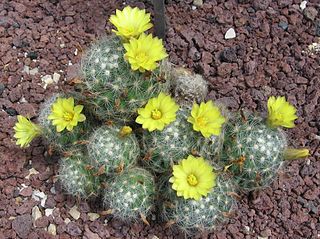
Mammillaria baumii is a species of cactus in the subfamily Cactoideae. It is endemic to Mexico. It was named for botanist Hugo Baum.
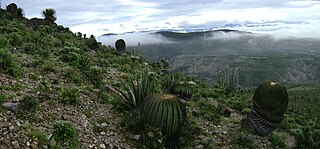
The Tehuacán-Cuicatlán biosphere reserve is a protected natural area located in southeastern Mexico. Its name derives from its two main locations: Cuicatlán and Tehuacán, in the latter are their administrative offices, covers 490,186 hectares distributed among 21 municipalities in the state of Puebla and Oaxaca.
Mammillaria elegans is a species of cacti in the tribe Cacteae. It is native to Mexico. Mammillaria elegans A.P. de Candolle 1828. is a 'nomen confusum' also applied to Mammillaria haageana subsp. elegans and refers both to Mammillaria geminispina with latex in the stem and to Mammillaria haageana, without latex in the stem Habit: Solitary, seldom branching cactus.
The Janos Biosphere Reserve is a nature reserve in Janos, Chihuahua, Mexico. It protects a prairie ecosystem best known for its recovering and reintroduced species most notably the herd of American bison which became the first re-established in Mexico. It is the first federally protected area of Mexico with the main objective of protecting a grassland ecosystem.

Mammillaria fraileana is one of about 200 species of the genus Mammillaria from the cactus family Cactaceae. This species is native to Mexico and can be found along the east coast of the southern part of Baja California Peninsula in Desert Scrub communities. They tend to grow in non-calcareous dry granite-based soil but can also grow in rocky habitats, either in rock fissures or directly on top of the rock surface even without the presence of soil. Thus, the mineral composition of the rocks in their habitat directly influence their abundance. The habitat of Mammillaria fraileana is home to succulent flora and is particularly rich in local endemics. Currently, no major threats to the species are known to exist.

Mammillaria sphaerica, the longmamma nipple cactus or pale mammillaria is a species of flowering plant in the cactus family Cactaceae, native to south eastern Texas in the USA and north eastern Mexico, where it occurs in scattered patches at altitudes up to 1,000 m (3,300 ft). It forms clumps of small pale green spheres to 5 cm (2.0 in) in diameter, with short hairs and pale yellow flowers up to 3 cm (1.2 in) wide in summer.

Mammillaria haageana is a species of cacti in the tribe Cacteae. It is native to Mexico, where it is found commonly, and is widespread throughout much of the country.

Mammillaria pringlei, called the lemon ball, is a species of cactus in the genus Mammillaria, native to Mexico, from Querétaro through to Veracruz and on to México State. It has gained the Royal Horticultural Society's Award of Garden Merit.


















